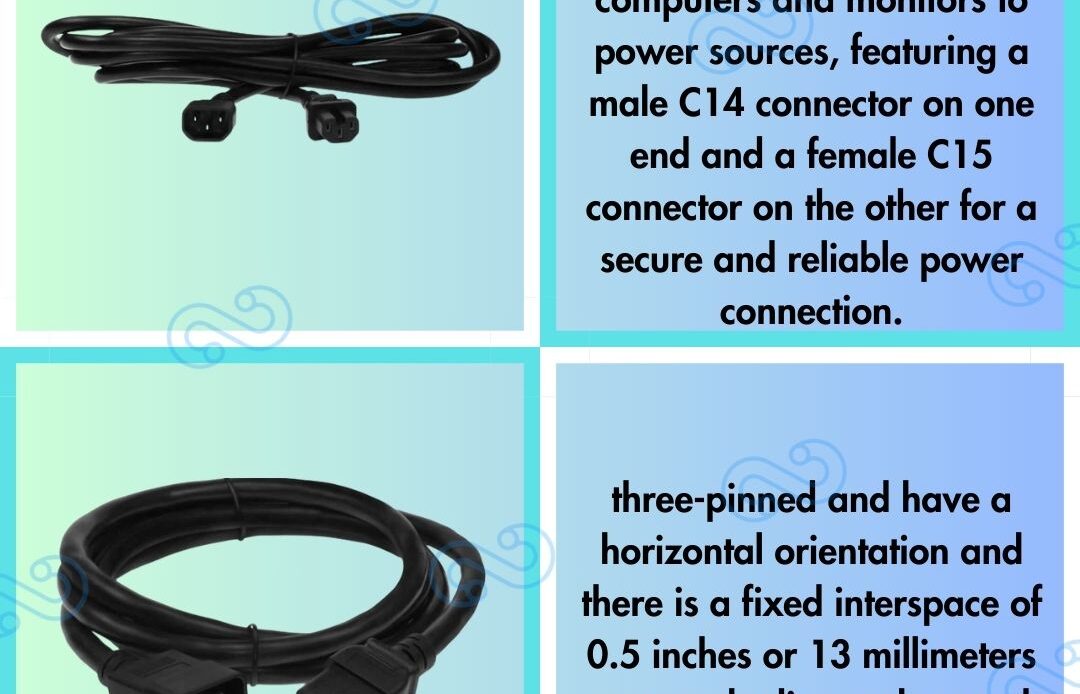Here, in this article, we will try to give you in-depth knowledge on power cords like what they actually are, the types, like the c14 to c15 power cord, available with us in SF Cable and the safety guidelines that we must follow after we purchase one.
Power Cord – What It Actually Is?
The basic function of a power cord is to set a connection between different appliances with their power supply source. These power cords are made from insulat cables whose one or both ends are integrate with the connectors. And any one end of the connector is a male connector and this one is plugg into the plug-in socket.
The opposite end of the male connector is the female connector attached to the appliance or to some other male connector. The female connector is omitted and replaced by fixed cables. Here are some common connectors like the c14 to c15 power cord or the c19 to c20 power cord that are available with us at SF Cable:
C14
This is a Euromain or IEC Cold Connector and its rating is 10 amperes and the length is 6.6 ft or 2 m, 32.8 ft or 10 m and the temperature it can sustain is 158°f or 70°C. These are the specifications of a common connector and are commonly found in desktops, projectors, printers, and monitors.
C15
These connectors are most commonly use in industrial applications and in Class I equipment. They are call kettle lead or IEC Hot Connector and come with current and temperature ratings of 10 amperes and 248 or 120-degree centigrade and 311 degrees Fahrenheit or 155-degree centigrade. They can be polarize, earth and rewireable.
C19 and C20
The c19 to c20 power cord are three-pinned and have a horizontal orientation and there is a fixed interspace of 0.5 inches or 13 millimetres among the live and neutral pins. The connector has rectangular moulding and is border by fillets. The earthing pin also has a space of 0.3 inches or 8 millimetres.
The current rating is 16 amperes and a temperature rating of 158-degree Fahrenheit or 70 degrees centigrade. It finds its specific application in applications that need higher electrical supplies and where C13/C14 connectors cannot be use. It can be polarized, earthed and rewireable.
The Safety Rules for Handling Power Cords
Here are some safety steps you should follow after you purchase a power cord from our concern, SF Cable. Let’s discuss the dos and don’ts for your safety.
Dos
- Don’t ever keep the cords dangling from the walls after its use. This will help you in preventing electrical accidents.
- Always keep the extension cord away from direct heat and water or else these two can destroy the insulation of your power cord. And if the insulation is affect, you may face a shock hazard.
- The insertion of a power cord should be spacious. Avoid too many insertions in a small area. This may again result in damage to the insulation. Declutter your computer cable.
Don’ts
- Do not start using the power cord in the coiled state soon after unboxing. First, go for unwinding and then before plugging in as it may get overheat in a coiled state.
- Cords, when kept under confinement or pressure, may get overheat and cause serious danger to the user. Moreover, people may also trip and fall on them.
- Never ever stack the plugs or else it may lead to overheating of the power point which may lead to a fire breakout.
Conclusion
A power cord is the most vital electrical component that connects different appliances to the power source. It is basically made of insulat electrical cables whose both ends are mould with the connectors.
The components of a cable are a plug, a power cable, and a connector. This connects the appliance to the power supply. The interconnection cord set consists of a male and female connector and connects only two appliances.
The plugs and the sockets’ inner configuration may be different owing to the local regulations. It is so because the electrical standards vary from region to region and this is universally true in the case of specific electrical parts. The criteria created by the IEC are based on the number of pins, dimensions, safety features, etc. that influence the grouping system of the plugs. These groups have similar characteristics.
If your life revolves around computers, then the power cords are definitely your lifeline. To maintain that lifeline in perfect shape, SF Cable suggests that you should keep this list of do’s and don’ts handy with you. To prevent and avert big catastrophes, you must follow the list to the tee to save your family and friends from a fire or a short circuit due to faulty electrical power cords. Always be careful while handling this seemingly simple thing. Be safe and keep safe.



